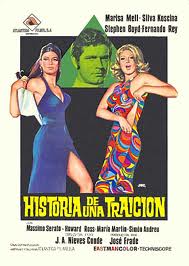
The Heat of the Flame and The Great Swindle are two obscure Spanish thrillers from the 1970s. Spanish thrillers of the period are generally unexplored territory, and it’s curious seeing them in relation to the Italian gialli. The Hispanic variant more closely resemble the films being made in Italy during the late 1960s, before Dario Argento established the formulaic standard of having a mysterious killer bumping off the rest of the cast in a series of violent set-pieces; instead they spend more time setting up the dramatic situation between assorted characters motivated to kill by greed, jealousy or desire. They feature limited amounts of violence (as opposed to the Italian films) and increasing amounts of nudity, reflecting the creeping sense of social liberation during the final years of General Franco’s rule.
The Heat of the Flame (aka El calor de la llama) is the more trashy, crude but also interesting of the two films. Made in 1976, the year after Franco’s death, it borrows more heavily from the Argento model and also features some quite extreme sexual violence – this is about as politically incorrect as it’s possible to get. Gabriela (Australian actress Christine McClure) is unhappily married to bank manager Javier (Antonio Ferrandis), who is both much older than her and preoccupied with his tedious bid to become Mayor. She spends her time discussing life with drunken, Hemmingway-esque writer Carlos (Francsico Nieto) and looking nostalgically back upon her affair with local priest Luis (Antonio Mayans). In the meantime a psychopath is terrorising the local area, raping and killing local women, distinguished by the discordant whistle he uses while stalking his victims (quite how the police know about this habit when all of his victims are dead is never explained). When Gabriela is kidnapped, imprisoned and sexually abused by the masked killer, she ends up enjoying the experience (natch) and returns for more… but who could the mysterious killer be.
This is a low budget affair that spends a lot of time setting up the situation, making it more like a melodrama into which the thriller aspects have been inserted at the last moment. But despite the slow start, the preoccupation with hang-gliding (which must have been fashionable given it’s frequent appearance in European B-Movies at the time) and the obviousness of the killer’s real identity it eventually gets under your skin. This is partially down to the snowy, mountainous locations, which are exactly what you don’t expect from a thriller, but acknowledgement is also due to Rafael Romero Marchent (a talented director of westerns whose other work is sadly unappreciated) and Santiago Moncada, possibly the most talented Spanish genre scriptwriter (he also wrote classics like The Corruption of Chris Miller and The Bell of Hell).

The Great Swindle is a technically superior film, but more draggy. Carla (Marisa Mell), a high class escort, is gutted when her favourite client Luis (Fernando Rey) hooks up with her best friend Lola (Maria Martin). She embarks on an affair with Hemmingway-esque painter Arthur (Stephen Boyd), who turns out to be a conman out to swindle her. Rather than going to the police, she enrols him into a scheme to set up Lola for Luis’s murder, thereby allowing them to make off with all of his money. Unfortunately, Arthur and Lola begin to fall for each other.
This isn’t really a mystery as you’re pretty much always aware of what’s going on, even though the fragmented narrative approach does its best to blur the facts as much as possible. As with The Heat of the Flame it’s a melodramatic concoction, with vast stretches of the running time given over to the developing relationships between the characters, before it’s revealed to have a giallo style twist at the end. The sex here is less extreme than in The Heat of the Flame, and the only murder that there is happens off-screen, although the interiors and fashions are pretty deadly (wallpaper on wardrobe doors, nice!) But it’s decently made, with good direction by José Antonio Nieves Conde, an experienced filmmaker who’d been working with some success since the postwar years and who also made another film with Stephen Boyd and Marisa Mell, Marta, the same year. There’s good cinematography, an excellent soundtrack from Carlo Savina and a great cast including the likes of Massimo Serato (hedonistic dandy), Howard Ross (young stud) and Simon Andreu (hunky pilot) in small supporting roles.
Although both films are flawed, they’re fascinating to examine in relationship to their Italian equivalents and as products of their place, time and political situation. As someone who much prefers the 60s gialli to the post Argento strand, despite being less slick and streamlined they’re in many ways preferable to many of the thrillers being made in Italy at the same time. Well worth checking out.